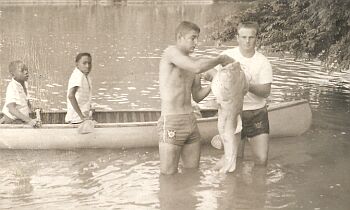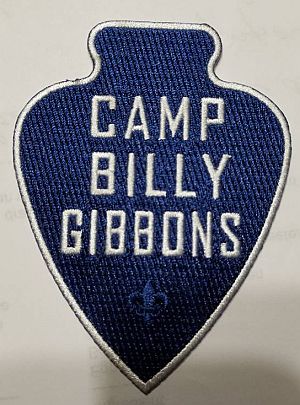 |
|||
New Camp Billy Gibbons - 1947
On April 6, 1947, C. N. Quirl, Scout Executive, announced that Mr. and Mrs. John W. Gibbons, owners of an 18,000 acre ranch, had given 103 acres on Brady Creek to the Comanche Trail Council for a new scout camp to be named Camp Billy Gibbons. He also announced that the Scouts had access to 32,000 acres of the John W. and Harold Gibbons ranches. Instead of the Council having a lease to the land, the land was to be deeded to the Council so that they would own the land so long as it was used it for camping. A settlement was then made with Jake Hamon for the council to surrender the remainder of the 25-year lease in exchange for Hamon paying the council $12,500. The council kept the right to salvage material from the old Camp Billy Gibbons for use in building the new camp.
A survey was made of the new property and the deed was filed for record on August 22, 1947. In 1948, John Gibbons was presented the Silver Beaver, the highest award a council could give a Scouter for unselfish service to boys, as a recognition of his gift to the the council. Excerpts From The Deed“The above described premises abut and adjoin Brady Creek and we hereby give, grant and convey unto Comanche Trail Council, Inc., Boy Scouts of America, all riparian rights owned and held by us in such Brady Creek by reason of our having been the owners of the lands hereby conveyed. “It is understood that the failure of Grantee, its successors or assigns, to hold or have the annual Boy Scout Encampment on the premises herein conveyed for a period of three successive years shall constitute prima facie evidence that said premises have been abandoned for Boy Scout purposes and upon the happening of such an occurrence the title and possession of said premises will immediately revert to and vest in Grantors, their heirs, executors and legal representatives. “It is understood however, that the Grantors herein expressly reserve for themselves, their heirs, legal representatives and assigns the right to use such premises for ranching and grazing purposes.” To read the entire deed to Camp Billy Gibbons from the Gibbons go HERE. Road BuiltFirst Summer - 1947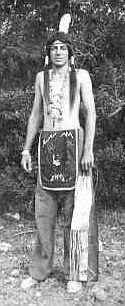 A well was drilled 105 feet deep to provide
water for the camp. They did have the dam across
the river built in time for the opening of camp,
so the Scouts did all their swimming and canoeing in
the new swimming hole in Brady Creek. The eight
foot high dam was only half as long as it is
today. They put archery and rifle shooting down
in the Plum Hollow Creek bed across what is now the
Order of the Arrow ring. They shot against the
rock wall. A well was drilled 105 feet deep to provide
water for the camp. They did have the dam across
the river built in time for the opening of camp,
so the Scouts did all their swimming and canoeing in
the new swimming hole in Brady Creek. The eight
foot high dam was only half as long as it is
today. They put archery and rifle shooting down
in the Plum Hollow Creek bed across what is now the
Order of the Arrow ring. They shot against the
rock wall.
The summer camp operated with four weeks of camp the first summer, instead of the usual two weeks at the old camp. Dates for the operation of the camp were June 24-July 1, July 1-July 8, July 8-July 15 and July 15-July 22, 1947. Running Elk (Gaitha Browning pictured at right) conducted a program of Indian Lore and Indian dances that first summer. He considered the camp ideal for all types of Indian lore work. Running Elk had wide experience with both Indians and Scouts, having spent more than three years on the Navajo reservation as an Indian trader and having traveled widely over the Indian country of the Southwest, gathering dances and ceremonies for camp use. For six summers he was director of Indian lore work in A. A. Jameson's Dixie Camps in the blue Ridge Mountains. He also spent many years doing the same thing in Scout camps over Texas. Running Elk had been actively associated with the camp, but this was his first season there since his return from overseas duty. One of the features of the camp was a Rain Dance staged by the Indian Lore classes under the direction of Browning. The drums in the council ring were kept busy for 24 hours with numbers of the Scouts taking two-hour shifts beating the drums. Just as the Rain Dance was completed in the council ring on Friday night, July 4, 1947, it began to sprinkle. However, there was no general rain although threatening rain almost disrupted the Friday night council ring program. Homer Tudor and Russell Thorn of Breckenridge directed the waterfront activities. C. L. Burns, Brownwood was in charge of the mess hall. On Sunday, July 6, 1947, Elmo Letbetter, Cubmaster of Pack 2, First Baptist Church, Brownwood, took his Cubs to the camp. He invited other Pack to join his "kids" in a trip to the camp. They planned on reaching camp in time for the Sunday morning religious service and were to eat lunch with the older boys and attend the water contest in the afternoon. There were approximately 150 boys in camp that week. We were unable to find a story to tell us what actually happened that Sunday and if any other packs came to camp with Pack 2. Camp Patches
New Dining Hall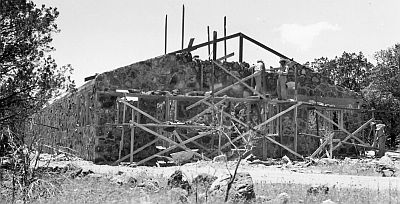 A dining hall was
finally built using a rock mason, one carpenter and
senior Scouts. Workers from Richland
Springs were in charge of the construction. They had
four donkeys and four sleds that the Scouts used to
bring in surface rocks picked up in the pasture.
The 40 by 140 foot concrete slab was poured
using a mixer that was hand driven. It took them
forever to finish the floor. Three rooms were
added at the end of the dining hall and were used as a
first aid room, an office and a canteen. The work was
finished in time for the first summer session at camp
on June 24, 1947. A dining hall was
finally built using a rock mason, one carpenter and
senior Scouts. Workers from Richland
Springs were in charge of the construction. They had
four donkeys and four sleds that the Scouts used to
bring in surface rocks picked up in the pasture.
The 40 by 140 foot concrete slab was poured
using a mixer that was hand driven. It took them
forever to finish the floor. Three rooms were
added at the end of the dining hall and were used as a
first aid room, an office and a canteen. The work was
finished in time for the first summer session at camp
on June 24, 1947.
The photo above left shows workmen putting the finishing touches on the ourside walls of the new "mess hall." A concrete floor was poured in the building the previous week, and the roof had been started. The native stone building is 116 feet long by 40 feet wide. 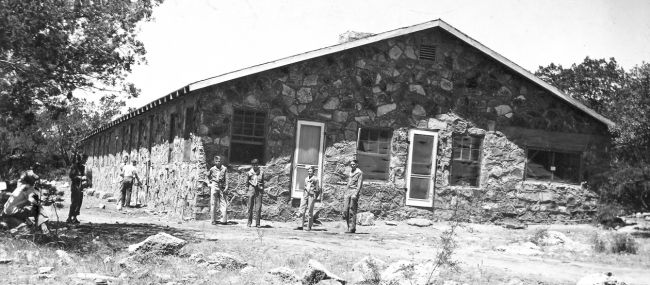
The council met their goal of having the road, dam and mess hall completed before the camp opened June 24. Materials from the old camp were utilized in the construction of the new camp. Temporary Latrines At FirstFor water utilities the ground had too much rock to bury the galvanized water pipe. They had to lay it on top of the ground and cover it with rock. Later, in 1953, the Order of the Arrow, using a mixer, poured the slab for the front porch of the dining hall. It was poured in three sections, one at each encampment. A roof was added to the porch later.
Ben Overton
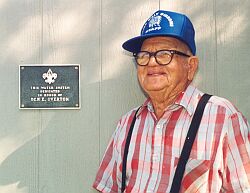 Once electricity
was brought into the camp, and new submergible pump
was installed along with storage tanks and a new
pressure system. Ben Overton, well man, from
Lake Brownwood took over the job of maintaining the
system for many years. The Council Executive Board
paid honor to him when they names the pump house in
his name for the years of free service he gave to the
water system. Once electricity
was brought into the camp, and new submergible pump
was installed along with storage tanks and a new
pressure system. Ben Overton, well man, from
Lake Brownwood took over the job of maintaining the
system for many years. The Council Executive Board
paid honor to him when they names the pump house in
his name for the years of free service he gave to the
water system.
During 1984, an addition was completed on the kitchen end of the dining hall thanks to Seth Moore, Jr. and a group of dedicated volunteers. The 10 foot by 40 foot addition provided a back porch for storage and refrigerators. Another sectioned off part was used for the camp office. Dam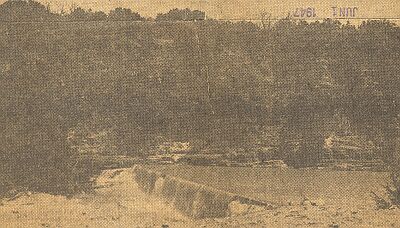 The dam was completed and later had a
handrail that went across the dam for people to hold
on to. The dam remained the size it was (as shown in
the picture to your right) until In 1955, a flood
washed out the end of the dam closest to camp and also
the handrails. The dam was completed and later had a
handrail that went across the dam for people to hold
on to. The dam remained the size it was (as shown in
the picture to your right) until In 1955, a flood
washed out the end of the dam closest to camp and also
the handrails.
J. B. Boler, a member of the council board, was put in charge of the project to rebuild the dam. The cost of repairing and extending the dam was $1,950. By July 29, 1955, the excavation for the project was completed and the forms were being built for pouring of the cement. The dam was extended all the way to the rock bank and was completed the week of August 12, 1955. The contractor was paid in full on August 29. A special campaign was held to raise this emergency money. By the time they paid the contractor, they had raised $1,431. They had to borrow $519 from the bank to pay him completely. The dam is still holding today even though there has been as much as eight feet of water flowing over the dam during floods. Trees PlantedScouts and leaders attending this first winter camp came from Breckenridge, Eastland, Stephenville, Lampasas, Richland Springs, Mullin and Brownwood. Steve Potts, field executive, directed the camp, assisted by scoutmasters of the various troops. ElectricityHowever, it was 1961 before all the electricity was installed. The Order of the Arrow Section Conclave in August of that summer had electricity and refrigeration in the dining hall. An appreciation barbecue was held at camp in December of 1961 to thank the donors of money, time and talent to get the electricity to camp. An Arrow Coach Line bus transported the group to camp. A new kitchen was built in 1962, and air conditioning was added to the kitchen in 1997. Gee LodgeA new Cook’s Cabin was built in 1964 for the cooks. It was a one-room framed building. That building is now used for storage of summer camp equipment as the cooks have been moved to the rear of the dining hall. The Terrell Foundation in 1967 gave a $5,000 matching grant for improvements at Camp Billy Gibbons provided that the council could raise $5,000 by June 1 of that year. Dr. T. C. Graves headed up the campaign and they met their goal. Using the money from the grant, by May 1968, they had relocated some campsites and built new pit latrines on every campsite with a wash stand and drinking water. The lumber for the latrines was precut at Dr. Fred Spence’s home and brought out to camp and put together. The council also redesigned the water supply and distribution system for camp. The old galvanized pipe was replaced by black plastic pipe from Phillips Driscopipe. Water was now provided to all campsites. Trading Post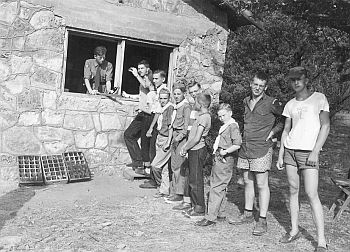 As mentioned
above, the first "canteen," or trading post as it was
later called, was on the end of the dining hall.
The picture to the left shows how the canteen looked
when it was finished and opened for business.
This picture was taken in 1948. Burts Kennedy
was the canteen director. As mentioned
above, the first "canteen," or trading post as it was
later called, was on the end of the dining hall.
The picture to the left shows how the canteen looked
when it was finished and opened for business.
This picture was taken in 1948. Burts Kennedy
was the canteen director.
A rock trading post with a metal roof eating area was built in front of the dining hall in 1972-73 to replace a brush arbor that had been built earlier by the Order of the Arrow. During 1980 the Central Texas Telephone Cooperative put all of the phone lines underground. They had an easy job of burying the cable until they got to camp where they discovered solid rock. From the entrance of camp to the dining hall, they had to use a rock saw to cut a hole in the ground for the cable. During the tenure of Alford Havens as Scout Executive in the 1980’s, a camp office was added onto the end of the dining hall, a metal roof put on the dining hall porch, a new rifle range was built and a health lodge room built inside part of Gee Lodge. In 1997 a handicapped restroom was added to the camp. Rifle Range
In 1985, a pavilion in honor of Seth Moore was built at the range and other improvements were made to the backstops. They removed the bullet traps and mounted sheet metal, at a forty-five degree angle, across the back of the range against the spools and added rubber tires to catch the bullets. This worked well for many years until the metal became pitted from people shooting black powder rifles at it. New First Aid Lodge
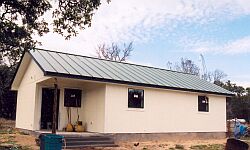 In the mid 90’s, the council had to tear the
backstop system down and close the range. Now
the camp used only BB Guns to teach rifle safety and
shooting on the range. A new rifle range was
built in 1999 closer to the entrance to camp and the
camp went back to using 22 cal. single shot
rifles. In the mid 90’s, the council had to tear the
backstop system down and close the range. Now
the camp used only BB Guns to teach rifle safety and
shooting on the range. A new rifle range was
built in 1999 closer to the entrance to camp and the
camp went back to using 22 cal. single shot
rifles.
In late 2002, the National Order of the Arrow gave a grant for $4,000 to help build a new First Aid Lodge. With additional donated money, donated materials and labor, the lodge was completed in early 2003. It is estimated to be worth $30,000. New Shelter Added in 2006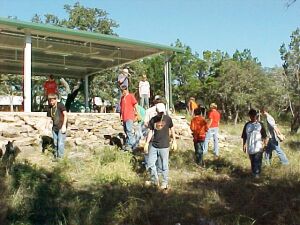 A new pavilion was added to the camp in 2006
in memory of Brian Kendal Iley, an Eagle Scout from
Troop 39, Stephenville, and Summer Camp Staff member,
who was killed in an accident. The money for the
shelter was donated as a memorial to the Scout and
mostly volunteer labor built the pavilion. It
has water, lights, ceiling fans and a concrete floor.
Shown to your left are members of the Order of the
Arrow adding rocks to the slope of the pavilion to
prevent erosion in October 2006. A new pavilion was added to the camp in 2006
in memory of Brian Kendal Iley, an Eagle Scout from
Troop 39, Stephenville, and Summer Camp Staff member,
who was killed in an accident. The money for the
shelter was donated as a memorial to the Scout and
mostly volunteer labor built the pavilion. It
has water, lights, ceiling fans and a concrete floor.
Shown to your left are members of the Order of the
Arrow adding rocks to the slope of the pavilion to
prevent erosion in October 2006.
Animals and Fish AplentyIf one is bold enough on a hot summer night to sleep outside on a cot, they might wake up in the middle of the night with a raccoon sitting on their chest. If food is left out at night, it might be gone the next morning, eaten and scattered by the raccoons. Scouts always seem to be able to scare up a rattlesnake, armadillo or skunk in the most unlikely places and decide to do a “show and tell” with their Scoutmaster.
To read more about this famous catfish, just click on the picture. Bill Lynn tells the story about the time that he had taken a group of new Scouts to camp, and as was the custom in those days, took them on a “Snipe Hunt.” Now, for those of you who don't know, a snipe hunt is where you take new Scouts out into the woods and give them a gunny sack to hold open while some of the older, more experience Scouts scare up the snipes to run toward the new Scouts for them to catch them in the sacks. Of course there are no such actual snipes, but the new Scouts don't know this. They may sit out there for several hours waiting for the snipes to show up. On this occasion, they took the Scouts out and positioned them next to the river and had them hold their sacks in just the right way to catch a snipe. The Scoutmaster and older boys went down the road and started beating on a drum to scare up the snipes. Well, they scared up something all right, wild pigs. The pigs ran down river from the noise and straight into the new Scouts. One of the wild pigs ran right into the sack being held by Jimmy Wilkins! It scared Jimmy half to death and he dropped the sack and ran for his life. The only problem was that he ran toward the river and first thing he knew he was in the river. All the other Scouts managed to stay on land and give quite a few hoots to a rather wet Wilkins. By the way, Jimmy Wilkins later went on to become a Lodge Chief of the Otena Lodge, Order of the Arrow, and was also the brother of Ric Wilkins who caught the catfish that hangs above the fireplace. Drill Holes To Hold Up TentsThe camp is maintained by the volunteers of the Comanche Trail Council and provides the "glue" that keeps the smallest Council in the Southern Region going! Scouters can take pride in the work they have accomplished over the years in making Camp Billy Gibbons the camp that it is today. Most High Order of the Donkey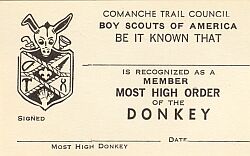 One means by which the council maintains the
camp is through Donkey Day held each spring.
Volunteers come out for a day of work to either build
structures, repair existing structures or just clean
up camp. One means by which the council maintains the
camp is through Donkey Day held each spring.
Volunteers come out for a day of work to either build
structures, repair existing structures or just clean
up camp.
The first Donkey Day was held on May 18, 1968, and has been held every spring since then. In the beginning, each person who came out and worked for eight hours was inducted into the “Most High Order of the Donkey.” The candidates enter the sacred circle by two’s. Each person held on to a rope. Donkey ears were install with fanfare on the Most High Donkey. During the ceremony, the Keeper of the Donkey Shoes gave each person a rock to remind them of the heavy burden they carried. After drinking from a cup of unknown content, they were blindfolded and asked to get on all fours. Then a small saddle was put on one and then the next. They then were asked to bray. After having a bit put in their mouth, they were asked to repeat the oath of the sacred order. Each new member was given a card in recognition as a member of the “Most High Order of the Donkey.” Camp Still Serves Boys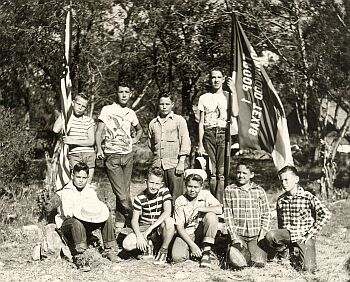 On your left is a picture of Troop 1 of
Brownwood, Texas taken at camp in the early 50's. Don
Buckmaster is the person on the far left sitting. Leo
Buckmaster, his brother, is the person third from the
left standing. Both Scouts earned their Eagle
Rank in 1953 and both served as officers in Otena
Lodge from 1954 through 1957. During their
Scouting days they both served on the summer camp
staff. Others in the photo are Left to Right: Don
Buckmaster, David Allen, Douglas Marick, H. D. Morgan,
David Taylor. 2nd Row: Don Turner, John
Scott Thompson, Leo Buckmaster, Joe McFarland On your left is a picture of Troop 1 of
Brownwood, Texas taken at camp in the early 50's. Don
Buckmaster is the person on the far left sitting. Leo
Buckmaster, his brother, is the person third from the
left standing. Both Scouts earned their Eagle
Rank in 1953 and both served as officers in Otena
Lodge from 1954 through 1957. During their
Scouting days they both served on the summer camp
staff. Others in the photo are Left to Right: Don
Buckmaster, David Allen, Douglas Marick, H. D. Morgan,
David Taylor. 2nd Row: Don Turner, John
Scott Thompson, Leo Buckmaster, Joe McFarland
Camp Billy Gibbons has served thousands of Scouts of over the years. Camp Billy Gibbons now has third generation Scouts attending summer camp and swimming in the same river as their grandfathers did. The camp is considered the last of the summer wilderness camps in this area. One must drive down a thirteen mile gravel road, over fourteen cattle guards, in order to get to the camp. Some claim that when the county grades the road to camp that all they do is sharpen the flint stone in the roadbed as many people still get flats when the road is graded. The camp is located fifteen miles southwest of Richland Springs, Texas, on the north bank of Brady Creek. The summer camp has a full program of aquatics, scoutcraft, conservation, archery, rifle and hiking. Some 175 to 200 Scouts participate in the camp each summer, learning how to set up their tents in very rocky ground and keeping the raccoons out of their campsite at night! The last summer for the Comanche Trail Council to operate the camp was in 2002. The camp is now operated by the Texas Trails Council and has seen an increase in its attendance over the past several years. In the
summer of 2009, one week of summer camp was held
with 110 Scouts and 30 adults in attendance.
For three days the temperature was over 100 degrees
but new swamp coolers in the dining hall, along with
new ceiling fans made for a tolerable
condition. It dipped down into the 70's at
night and they had rain on Monday, July 3rd.
Billy Gibbons will be used for staff training the
week of June 6-10, 2010, and have summer camp for
the boys the week of June 13-19, 2010 during the
100th Anniversary of Scouting. First Camp
Billy Gibbons Alumni Weekend 2018 The first
Camp Billy Gibbons Alumni Weekend was held May 4-6,
2018 with some 40 participants. They had a
great time and plan on having the reunion the first
weekend in May 2019. Go HERE
to see improvements made at camp from 2016-2018, 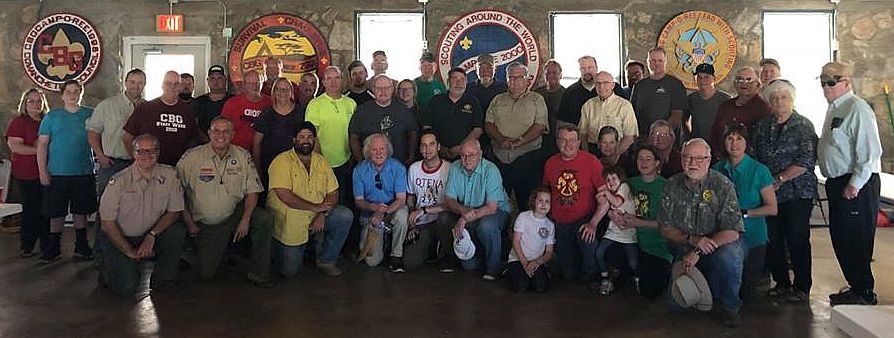
Those
in attendance at first Alumni Reunion in 2018
| Famous Mounted Catfish in Camp Billy Gibbons Dining Hall | History of the Dam | | Photos - "New" Camp Billy Gibbons | More Photos - "New" Camp Billy Gibbons | Yet More Photos | | Troop Photos at Camp | More Troop Photos | More Troop Photos | More Troop Photos | Last Troop Photos | | Third Week of Summer Camp in 1949 | Camp Improvements 2016-2018 | | Camp Billy Gibbons Alumni Association | CBG Junior Alumni Association | Billy Gibbons - The Person | | Newspaper Story on Acquiring Camp | "The Most High Order of the Donkey" | | Presented by John R. Wood at the Dedication Program for Historical Marker | | Troop 43's Canoe Trip to Camp Billy Gibbons from Brownwood in 1965 | | "I Remember - Old and New Camp Billy Gibbons by John M. Arthur | | Mays
Ranching
Company, Inc., owners of the Billy Gibbons
Ranch and the Ranch History | Go HERE for
story and photos on the "Old" Camp Billy Gibbons
Last
updated: June 27, 2024 |
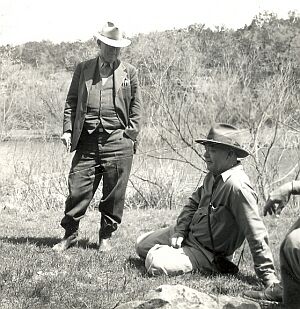 John Gibbons, the older son of Billy
Gibbons, who had also been a vice president of the
Executive Board since 1941, told the board that he
would give them a new campsite further up Brady
Creek for Camp Billy Gibbons after the old Camp
Billy Gibbons was denuded of trees by Jack L. Hamon,
Dallas oil man in 1947. The new area was known as
"The Blue Hole" and had a nice long pool in the
creek.
John Gibbons, the older son of Billy
Gibbons, who had also been a vice president of the
Executive Board since 1941, told the board that he
would give them a new campsite further up Brady
Creek for Camp Billy Gibbons after the old Camp
Billy Gibbons was denuded of trees by Jack L. Hamon,
Dallas oil man in 1947. The new area was known as
"The Blue Hole" and had a nice long pool in the
creek. 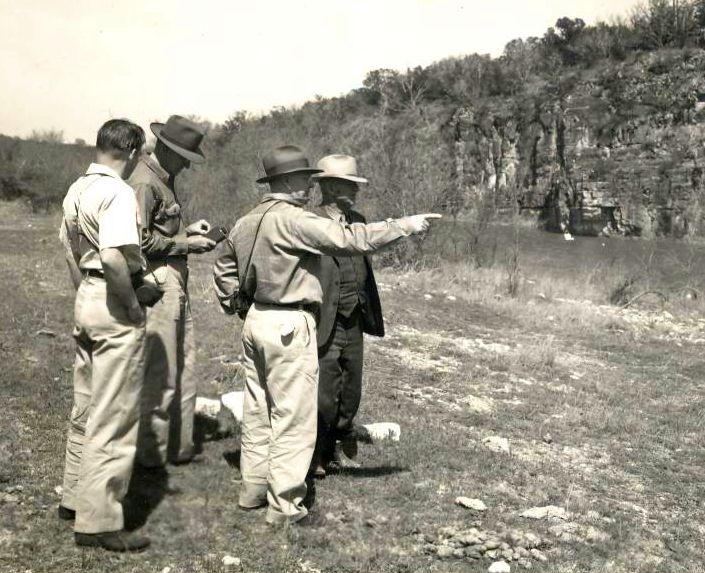

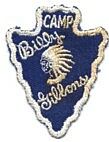
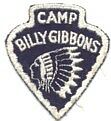
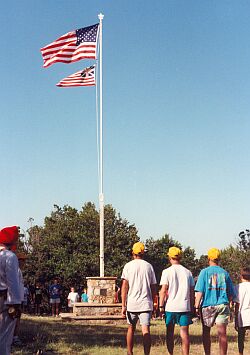 After the dining hall was completed, they
moved the base of the flag pole from the old camp to
the new camp as this was the original memorial to
Billy Gibbons. A bronze plaque of Billy
Gibbons, that had been used at the old camp and
provided by Dr. Taylor, a dentist from Lampasas, was
set in the base of the rock work. The plaque
is still there and on the other side of the flagpole
base, you will also find a plaque of a Boy Scout
that came from the old camp.
After the dining hall was completed, they
moved the base of the flag pole from the old camp to
the new camp as this was the original memorial to
Billy Gibbons. A bronze plaque of Billy
Gibbons, that had been used at the old camp and
provided by Dr. Taylor, a dentist from Lampasas, was
set in the base of the rock work. The plaque
is still there and on the other side of the flagpole
base, you will also find a plaque of a Boy Scout
that came from the old camp. 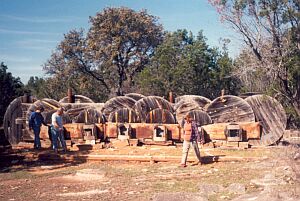 In 1965, the council decided the present
location was too dangerous and the range had to be
moved. Remembering that the camp was located
on solid rock, they decided the best thing to do was
to build a range with steel bullet traps.
Troop 22, along with Neal Pepper, Walter Walske,
Bill Lynn and several others, helped haul steel
plate to camp for the new range. They were
able to obtain some huge cable reels for the
backstop and mounted steel bullet traps on them. The
six bullet traps were made by Ross and Shelton
Manufacturing Company of Early.
In 1965, the council decided the present
location was too dangerous and the range had to be
moved. Remembering that the camp was located
on solid rock, they decided the best thing to do was
to build a range with steel bullet traps.
Troop 22, along with Neal Pepper, Walter Walske,
Bill Lynn and several others, helped haul steel
plate to camp for the new range. They were
able to obtain some huge cable reels for the
backstop and mounted steel bullet traps on them. The
six bullet traps were made by Ross and Shelton
Manufacturing Company of Early. 